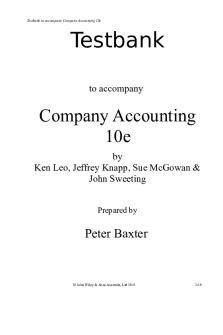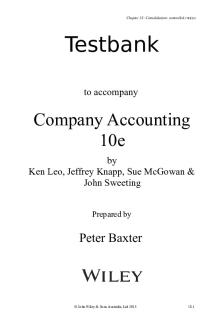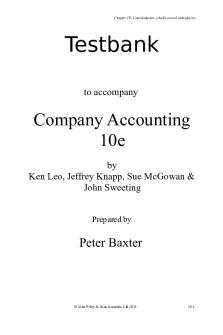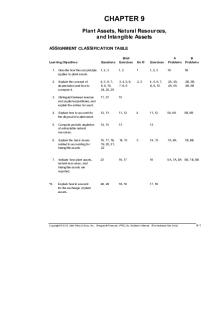Leo 10e ch09 Property,Plant And Equipment PDF

| Title | Leo 10e ch09 Property,Plant And Equipment |
|---|---|
| Author | Stewie Sim |
| Course | Intermediate Financial Accounting |
| Institution | Macquarie University |
| Pages | 58 |
| File Size | 1.2 MB |
| File Type | |
| Total Downloads | 99 |
| Total Views | 133 |
Summary
Download Leo 10e ch09 Property,Plant And Equipment PDF
Description
For use by students enrolled at Macquarie University for 2017 in ACCG224 (Intermediate Financial Accounting) only
C H A P T ER
Property, plant and equipment Chapter aim This chapter discusses the application of AASB 116 Property, Plant and Equipment. The objectives of this standard are: (a) to prescribe the accounting treatment for property, plant and equipment (b) to establish when property, plant and equipment should be recognised as assets (c) to prescribe how the carrying amounts of property, plant and equipment should be determined (d) to establish how depreciation charges should be determined.
Learning objectives After studying this chapter, you should be able to: 1 discuss the nature of property, plant and equipment (p. 396) 2 explain the recognition criteria for initial recognition of property, plant and equipment (p. 398) 3 describe how to measure property, plant and equipment on initial recognition (p. 400) 4 explain the alternative ways in which property, plant and equipment can be measured subsequent to initial recognition (p. 405) 5 explain the cost model of measurement and understand the nature and calculation of depreciation (p. 406) 6 explain the revaluation model of measurement (p. 414) 7 confirm the factors to consider when choosing which measurement model to apply (p. 427) 8 account for derecognition (p. 428) 9 apply the disclosure requirements of AASB 116 (p. 430).
Before you begin Before studying this chapter, you should:
All rights reserved. No part of this publication may be reproduced or used in any manner whatsoever without the prior written permission of the publisher, except in the case of brief quotations embodied in critical reviews and certain other noncommercial uses permitted by copyright law
9
AR N I
N
OB
E
1
G
LE
For use by students enrolled at Macquarie University for 2017 in ACCG224 (Intermediate Financial Accounting) only
V
J EC TI
9.1 The nature of property, plant and equipment
Discuss the nature of property, plant and equipment.
The accounting standard analysed in this chapter is AASB 116 Property, Plant and Equipment. The standard was first issued by the International Accounting Standards Board (IASB) as IAS 16 in March 1982, amended on numerous occasions, exposed in May 2002 as part of the International Accounting Standard Board (IASB) project on improvements to international accounting standards (IASs), and issued in its present form in 2004. As a result of this process, the IASB has clarified selected matters and provided additional guidance. It has not reconsidered the fundamental approach to the accounting for property, plant and equipment contained in IAS 16. This standard was adopted by the AASB as AASB 116 in July 2004. According to paragraph 2 of AASB 116, the standard applies in accounting for property, plant and equipment except where another standard requires or permits a different accounting treatment. AASB 116 does not apply to property, plant and equipment classified as held for sale in accordance with AASB 5 Non-current Assets Held for Sale and Discontinued Operations; biological assets related to agricultural activity as these are accounted for under AASB 141 Agriculture; or mineral rights and mineral reserves such as oil, gas and similar non-regenerative resources. However, AASB 116 does apply to property, plant and equipment used to develop or maintain biological assets and mineral rights and reserves. Paragraph 6 of AASB 116 defines property, plant and equipment as follows: Property, plant and equipment are tangible items that: (a) are held for use in the production or supply of goods or services, for rental to others, or for administrative purposes; and (b) are expected to be used during more than one period.
Note the following. cussed in depth in chapter 11. However, a key feature of tangible assets is that they are physical assets, such as land, rather than non-physical, such as patents and trademarks. or administration. Assets that are held for sale, including land, or held for investment are not included under property, plant and equipment. Instead, assets held for sale are accounted for in accordance with AASB 5. one accounting period. Property, plant and equipment may be divided into classes for disclosure purposes, a class of assets being a grouping of assets of a similar nature and use in an entity’s operations. Examples of classes of property, plant and equipment are land, machinery, motor vehicles and office equipment. The notes to the statement of financial position of Boral Ltd, at 30 June 2013, as shown in figure 9.1, provide an indication of what is contained in that category as well as the reasons for the movements in this category of assets. In this chapter, accounting for property, plant and equipment is considered as follows: in the accounts is reported subsequent to acquisition, including the recording of any depreciation of the asset
396
Company Accounting | Tenth Edition
All rights reserved. No part of this publication may be reproduced or used in any manner whatsoever without the prior written permission of the publisher, except in the case of brief quotations embodied in critical reviews and certain other noncommercial uses permitted by copyright law
For use by students enrolled at Macquarie University for 2017 in ACCG224 (Intermediate Financial Accounting) only
Figure 9.1 Property, plant and equipment — Boral Ltd NOTES TO THE FINANCIAL STATEMENTS Boral Limited and Controlled Entities
14. Property, plant and equipment CONSOLIDATED
Land and buildings At cost Less: Accumulated depreciation, amortisation and impairment Mineral reserves and licences At cost Less: Accumulated amortisation and impairment Plant and equipment At cost Less: Accumulated depreciation and impairment Leased plant and equipment capitalised Less: Accumulated amortisation
2013 $ millions
2012 $ millions
1 434.1 (189.8)
1 377.5 (146.3)
1 244.3
1 231.2
148.1 (17.2)
150.3 (14.6)
130.9
135.7
4 594.7 (2 627.6)
4 607.9 (2 408.2)
1 967.1
2 199.7
5.1 (0.3)
0.5 (0.4)
4.8 1 971.9
0.1 2 199.8
Total
3 347.1
3 566.7
Reconciliations Land and buildings Balance at the beginning of the year Additions Disposals Acquisitions of entities or operations Disposals of entities or operations Transferred from other property, plant and equipment Impairment disclosed as significant items Transferred to assets held for sale Depreciation expense Net foreign currency exchange differences
1 231.2 24.7 (29.0 ) — — 25.1 (32.1) — (20.2 ) 44.6
1 035.9 4.3 (11.1 ) 202.8 (0.3) 43.6 (27.3 ) (9.9) (18.2) 11.4
Balance at the end of the year
1 244.3
1 231.2
Mineral reserves and licences Balance at the beginning of the year Disposals Acquisitions of entities or operations Transferred from other property, plant and equipment Impairment disclosed as significant items Amortisation expense Net foreign currency exchange differences
135.7 — — 1.4 (5.6 ) (3.2 ) 2.6
74.4 (6.2 ) 67.6 0.4 — (1.6 ) 1.1
130.9
135.7
Balance at the end of the year
(continued) All rights reserved. No part of this publication may be reproduced or used in any manner whatsoever without the prior written permission of the publisher, except in the case of brief quotations embodied in critical reviews and certain other noncommercial uses permitted by copyright law
Chapter 9 | Property, plant and equipment
397
For use by students enrolled at Macquarie University for 2017 in ACCG224 (Intermediate Financial Accounting) only
Figure 9.1 (continued) CONSOLIDATED
Plant and equipment Balance at the beginning of the year Additions Disposals Acquisitions of entities or operations Disposals of entities or operations Transferred to other property, plant and equipment Impairment disclosed as significant items Transferred to assets held for sale Transfer (to)/from other assets or liabilities Write-down of plant and equipment Depreciation expense Net foreign currency exchange difference Balance at the end of the year
2013 $ millions
2012 $ millions
2 199.8 268.7 (18.0 ) — — (26.5 ) (226.2) — (4.3) (5.0) (263.2 ) 47.0
1 784.6 404.5 (31.7) 410.1 (35.0) (44.0) (48.6) (5.2) 0.8 — (250.2) 14.5
1 971.9
2 199.8
Source: Boral Ltd (2013, pp. 82–3).
learning check
excludes intangible assets.
N AR I
N
OB
E
2
G
LE
for sale.
V
J EC TI
9.2 Initial recognition of property, plant and equipment
Explain the recognition criteria for initial recognition of property, plant and equipment.
Paragraph 7 of AASB 116 contains the principles for recognition of property, plant and equipment: The cost of an item of property, plant and equipment shall be recognised as an asset if, and only if: (a) it is probable that future economic benefits associated with the item will flow to the entity; and (b) the cost of the item can be measured reliably.
This is a general recognition principle for property, plant and equipment. It applies to the initial recognition of an asset, when parts of that asset are replaced, and when costs are incurred in relation to that asset during its useful life. To recognise a cost as an asset, the outlay must give rise to the expectation of future economic benefits. The criteria for recognition in paragraph 7 differ from the recognition criteria for the elements of financial statements in paragraph 83 of the Framework. Under the Framework, an asset can be recognised when the cost or value can be measured with reliability; under AASB 116, recognition can occur only if the cost can be measured reliably. Assets for which the cost cannot be reliably measured but whose initial fair value can be measured reliably cannot be recognised in the entity’s records.
9.2.1 Asset versus expense For most items of property, plant and equipment, the entity will incur some initial expenditure. One of the key problems for the entity is determining whether the outlay should be expensed or capitalised as an asset. As paragraph 7 of AASB 116 states, the elements of that decision relate to whether the entity expects there to be future economic benefits, whether the receipt of those 398
Company Accounting | Tenth Edition
All rights reserved. No part of this publication may be reproduced or used in any manner whatsoever without the prior written permission of the publisher, except in the case of brief quotations embodied in critical reviews and certain other noncommercial uses permitted by copyright law
For use by students enrolled at Macquarie University for 2017 in ACCG224 (Intermediate Financial Accounting) only
benefits is probable, and whether the benefits will flow specifically to the entity. As noted in paragraph 90 of the Framework, the expensing of outlays: does not imply either that the intention of management in incurring expenditure was other than to generate future economic benefits for the entity or that management was misguided. The only implication is that the degree of certainty that economic benefits will flow to the entity beyond the current accounting period is insufficient to warrant the recognition of an asset.
As property, plant and equipment consists of physical assets such as land and machinery, such assets are normally traded in a market. One test of the existence of future benefits is then to determine whether there exists a market for the item in question. A problem with some assets is that once items have been acquired and installed, there is no normal market for them. However, in many cases, the expected economic benefits arise because of the use of that asset in conjunction with other assets held by the entity. At a minimum, the future benefits would be the scrap value of the item. Where the assets are intangible, such as costs associated with the generation of software, the absence of a physical asset causes more problems in terms of asset recognition. Chapter 11 discusses in detail the problems associated with the recognition of intangible assets.
9.2.2 Separate assets — components The total property, plant and equipment of an entity may be broken down into separate assets. This is sometimes referred to as a ‘components’ approach to asset recognition. An entity allocates the amount initially recognised in respect of an asset to its component parts and accounts for each component separately. Paragraph 9 of AASB 116 notes that the identification of what constitutes a separate item or component of plant and equipment requires the exercise of judgement, because the standard does not prescribe the unit of measure for recognition. The key element in determining whether an asset should be further subdivided into its component parts is an analysis of what is going to happen in the future to that asset. Having identified an asset, the entity wants to recognise the expected benefits as they are consumed by the entity, with the recognition being in the period in which the benefits are received. Hence, if an asset has a number of components that have different useful lives then, in order for there to be an appropriate recognition of benefits consumed, components with different useful lives need to be identified and accounted for separately. For example, consider an aircraft as an item of property, plant and equipment. Is it sufficient to recognise the aircraft as a single asset? An analysis of the aircraft may reveal that there are various components of the aircraft that have different useful lives. Component parts of the aircraft include the engines, the frame of the aircraft and the fittings (seats, floor coverings and so on). It may be necessary to refit the aircraft every 5 years, whereas the engines may last twice as long. Similarly, an entity that deals with the refining of metals may have a blast furnace, the lining of which needs to be changed periodically. The lining of the blast furnace therefore needs to be separated from the external structure in terms of asset recognition and subsequent accounting for the asset. Further, as noted in paragraph 9 of AASB 116, it may be appropriate to aggregate individually insignificant items (such as moulds, tools and dies) and apply the criteria to the aggregate value.
9.2.3 Generation of future benefits Paragraph 11 of AASB 116 notes that certain assets may not of themselves generate future benefits, but instead it may be necessary for the entity itself to generate future benefits. For example, some items of property, plant and equipment may be acquired for safety or environmental reasons, such as equipment associated with the safe storage of dangerous chemicals. The entity’s generation of the benefits from use of the chemicals can occur only if the safety equipment exists. Hence, even if the safety equipment does not of itself generate cash flows, its existence is necessary for the entity to be able to use chemicals within the business.
learning check
ence of probable future economic benefits and (2) the ability to measure an asset’s cost reliably. assets acquired.
All rights reserved. No part of this publication may be reproduced or used in any manner whatsoever without the prior written permission of the publisher, except in the case of brief quotations embodied in critical reviews and certain other noncommercial uses permitted by copyright law
Chapter 9 | Property, plant and equipment
399
AR N I
N
OB
E
3
G
LE
For use by students enrolled at Macquarie University for 2017 in ACCG224 (Intermediate Financial Accounting) only
V
J EC TI
9.3 Initial measurement of property, plant and equipment
Describe how to measure property, plant and equipment on initial recognition.
Having established that an asset can be recognised, the entity must then assign to it a monetary amount. Paragraph 15 of AASB 116 contains the principles for initial measurement of property, plant and equipment: ‘An item of property, plant and equipment that qualifies for recognition as an asset shall be measured at its cost.’ Paragraph 16 specifies three components of cost, namely:
it is located. These items are considered separately in the following sections.
9.3.1 Purchase price ‘Purchase price’ is not defined in AASB 116, but paragraph 16(a) states that the purchase price includes import duties and non-refundable purchase taxes, and is calculated after deducting any trade discounts and rebates. The essence of what constitutes purchase price is found in the definition of cost in paragraph 6 of the standard, which states: ‘Cost is the amount of cash or cash equivalents paid or the fair value of the other consideration given to acquire an asset at the time of its acquisition or construction.’ Where an item of property, plant and equipment is acquired for cash, determination of the purchase price is relatively straightforward. One variation that may arise is that some or all of the cash payment is deferred. In this case, as noted in paragraph 23 of AASB 116, the cost is the cash price equivalent at the recognition date, determined by measuring the cash payments on a present value basis (done by discounting the cash flows). Interest is then recognised as the payments are made. More difficulties arise where the exchange involves assets other than cash. In a non-cash exchange, the acquiring entity receives a non-cash asset and in return provides a non-cash asset to the seller. In measuring the cost of the asset acquired, the question is whether the measurement should be based on the value of the asset given up by the acquirer, or by reference to the value of the asset acquired from the seller. In relation to the application of the cost principle of measurement, note the following. 1. Cost is determined by reference to the fair value of what is given up by the acquirer rather than by the fair value of the item acquired. The cost represents the sacrifice made by the acquirer. This principle is inherent in the definition of cost in paragraph 6 of AASB 116. Further, paragraph 26 states that where both the fair value of what is given up by the acquirer and the asset received are reliably measurable, then the fair value of the asset given up is used to measure the cost of the asset received, unless the fair value of the asset received is more clearly evident. ‘More clearly evident’ presumably relates to the cost and difficulty of determining the fair value as, in the paragraph 26 example, the fair values of both the asset received and the asset given up can be measured reliably. 2. Cost is measured by reference to fair value (paragraph 24). The term fair value is defined in paragraph 6 of AASB 116 as ‘the price that would be received to sell an asset or paid to transfer a liability in an orderly transaction between market participants at the measurement date’. Fair value is an exit price. The process of determining fair value necessarily involves judgement and estimation. The acquiring company is not actually trading the items given up in the marketplace for cash, but is trying to estimate what it would get for those items if it did so. Hence, the determination of fair value is only an estimation. A further practical problem in determining fair ...
Similar Free PDFs

ch21 sm leo 10e
- 107 Pages

Ch24 tb leo 10e - Ch24 tb leo 10e
- 15 Pages

Ch18 tb leo 10e - Ch18 tb leo 10e
- 16 Pages

Ch19 tb leo 10e - Ch19 tb leo 10e
- 17 Pages

Ch09
- 73 Pages

Property, Plant and Equipment
- 1 Pages

Capillary Puncture AND Equipment
- 3 Pages

Equipment-and-weather
- 7 Pages

Ch09 - accounting
- 56 Pages

Accounting ch09
- 68 Pages

Historia Clínca 1 - LEO
- 134 Pages
Popular Institutions
- Tinajero National High School - Annex
- Politeknik Caltex Riau
- Yokohama City University
- SGT University
- University of Al-Qadisiyah
- Divine Word College of Vigan
- Techniek College Rotterdam
- Universidade de Santiago
- Universiti Teknologi MARA Cawangan Johor Kampus Pasir Gudang
- Poltekkes Kemenkes Yogyakarta
- Baguio City National High School
- Colegio san marcos
- preparatoria uno
- Centro de Bachillerato Tecnológico Industrial y de Servicios No. 107
- Dalian Maritime University
- Quang Trung Secondary School
- Colegio Tecnológico en Informática
- Corporación Regional de Educación Superior
- Grupo CEDVA
- Dar Al Uloom University
- Centro de Estudios Preuniversitarios de la Universidad Nacional de Ingeniería
- 上智大学
- Aakash International School, Nuna Majara
- San Felipe Neri Catholic School
- Kang Chiao International School - New Taipei City
- Misamis Occidental National High School
- Institución Educativa Escuela Normal Juan Ladrilleros
- Kolehiyo ng Pantukan
- Batanes State College
- Instituto Continental
- Sekolah Menengah Kejuruan Kesehatan Kaltara (Tarakan)
- Colegio de La Inmaculada Concepcion - Cebu




